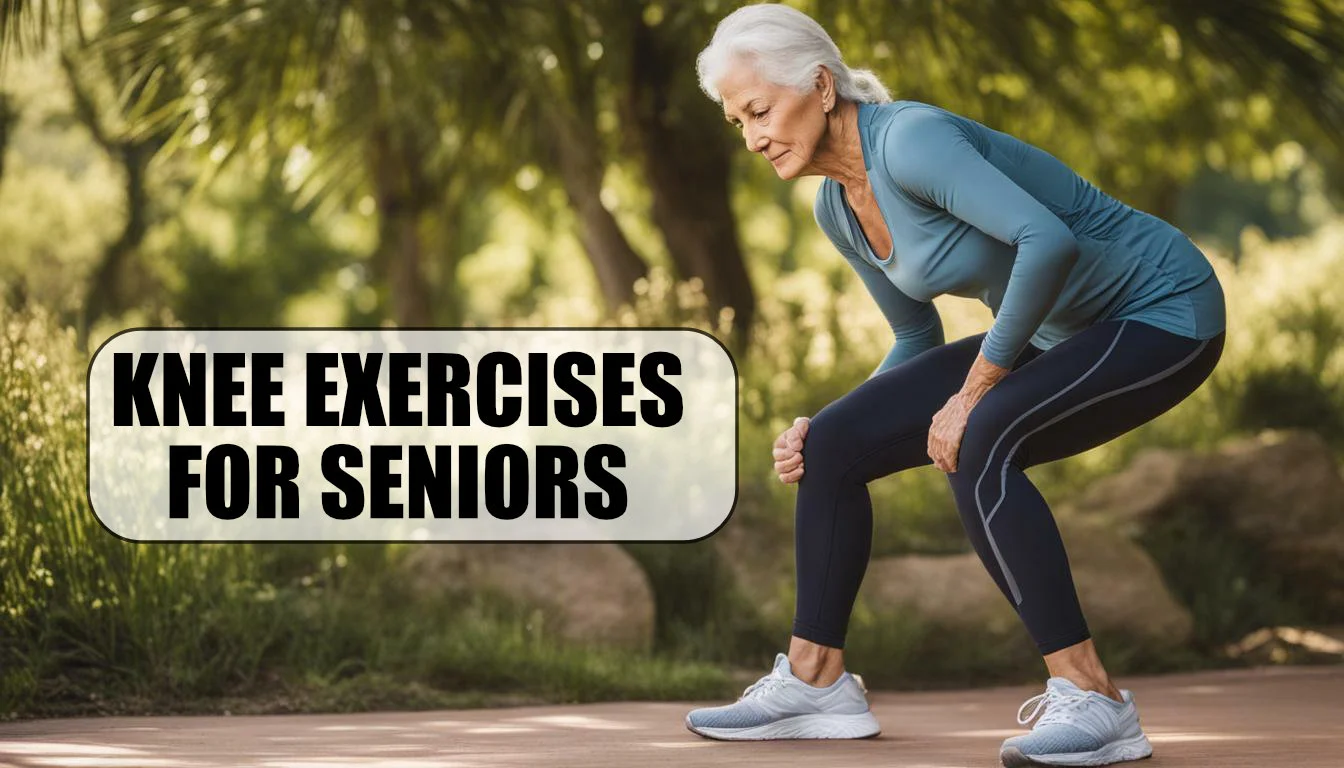Are you struggling with knee pain that’s affecting your everyday activities? Well, we have just the solution for you!
In this video by SilverSneakers, they demonstrate a series of exercises specifically designed to strengthen the muscles that protect your knees. And the best part is, you can try these exercises right at home with Jenny as your guide.
Don’t worry if you need some additional support, you can always use a chair to assist you.
So, let’s dive right in and start with these knee flexion and extension exercises. Remember, the key is to lead with your heels as you straighten and bend your legs, feeling the strength in your muscles.
As you progress, you can incorporate more repetitions and sets to improve your strength and alleviate your knee pain. Keep committed to your health and well-being and let’s get those knees back in action!
Best Knee Exercises for Seniors
Overview
As we age, our bodies may become more susceptible to various health issues, including knee pain and discomfort. However, incorporating regular exercise into your routine can help alleviate these symptoms and improve overall knee health.
In this article, we will explore the best knee exercises for seniors and provide detailed instructions on how to perform them correctly. By following these exercises, you can strengthen the muscles that support your knees and enjoy a higher quality of life.
Importance of Knee Exercises for Seniors
Knee exercises are crucial for seniors because they help to strengthen the muscles that support the knee joint. When these muscles are strong, they are better equipped to absorb shock and provide stability, reducing the risk of falls and injuries.
Additionally, regular exercise can improve flexibility and range of motion in the knees, allowing for easier movements and decreased discomfort. Engaging in knee exercises can also aid in weight management, which can alleviate pressure on the knees and enhance overall joint health.
Exercise Precautions for Seniors with Knee Pain
Before starting any new exercise program, it is important to consult with a healthcare professional, especially if you are experiencing knee pain or have a preexisting condition.
They can assess your specific needs and limitations and provide guidance on the most suitable exercises for you.
It is also essential to listen to your body and start slow, gradually increasing intensity and duration. If you experience any sharp pain or discomfort during an exercise, stop immediately and consult with a healthcare professional.
1. Knee Flexion and Extension
Description
Knee flexion and extension exercises focus on strengthening the muscles in the front and back of the thighs, which play a crucial role in knee stability and mobility.
Instructions
- Start by standing with your legs slightly bent and feet hip-width apart.
- Slowly lift one leg off the ground, keeping it straight and using your quadriceps muscles.
- Hold the lifted leg in the air for a few seconds, then lower it back down.
- Repeat the exercise with the opposite leg.
Benefits
Knee flexion and extension exercises can improve the strength and stability of the quadriceps muscles, which are essential for proper knee function. These exercises also promote range of motion and flexibility in the knees, reducing stiffness and discomfort.
2. Hamstring Curls
Description
Hamstring curls focus on strengthening the muscles at the back of the thighs, including the hamstrings, which are crucial for knee stability and flexibility.
Instructions
- Begin by standing straight, with your feet hip-width apart.
- Lift one leg off the ground, bending your knee and bringing your heel towards your glutes.
- Hold this position for a few seconds, then slowly lower your leg back down.
- Repeat the exercise with the opposite leg.
Benefits
Performing hamstring curls can help to strengthen the muscles at the back of the thighs, which play a vital role in knee stability. By strengthening these muscles, you can improve your balance and reduce the risk of falls and injuries.
3. Hip Extension
Description
Hip extensions target the hip and glute muscles, which play a significant role in providing stability to the knees.
Instructions
- Stand facing a wall or a sturdy surface, with your feet shoulder-width apart and hands on your hips.
- Lift one leg backward, keeping it straight, and extending it as far as comfortable.
- Hold this position for a few seconds, then slowly return your leg back to the starting position.
- Repeat the exercise with the opposite leg.
Benefits
Hip extension exercises can strengthen the hip and glute muscles, enhancing overall knee stability. By improving the strength of these muscles, you can reduce the strain on your knees during daily activities and exercise, promoting better knee health.
4. Stretching Exercises
Description
Stretching exercises can help improve flexibility and range of motion in the knees, reducing stiffness and discomfort.
Instructions
- Sit or lie down in a comfortable position.
- Extend one leg out in front of you and bend the other leg, placing your foot against the inner thigh of the extended leg.
- Gently lean forward, reaching towards your toes, while keeping your back straight.
- Hold the stretch for 15-30 seconds, then release.
- Repeat the stretch with the opposite leg.
Benefits
Regular stretching exercises can increase flexibility and range of motion in the knees, making daily movements easier and reducing the risk of injury. Stretching also helps to alleviate muscle tension, promoting relaxation and overall knee comfort.
5. Squats
Description
Squats are an effective exercise for strengthening multiple muscle groups, including the quadriceps, hamstrings, and glutes, which are all important for knee stability and mobility.
Instructions
- Stand with your feet shoulder-width apart, toes pointing slightly outward.
- Bend your knees and lower your body down as if you are sitting back into a chair, keeping your back straight and chest lifted.
- Stop when your thighs are parallel to the ground, or at a comfortable depth that avoids pain or discomfort.
- Push through your heels and lift your body back up to the starting position.
- Repeat the exercise for the desired number of repetitions.
Benefits
Squats can strengthen the muscles in the legs, including the quadriceps, hamstrings, and glutes, providing enhanced stability and support to the knees. By performing squats regularly, you can improve overall knee function and reduce the risk of falls and injuries.
6. Importance of Proper Form
Maintaining Proper Alignment
When performing knee exercises, it is crucial to maintain proper form and alignment to avoid putting unnecessary strain on your knees. Keep your knees aligned with your toes and avoid letting them collapse inward or outward. Engage your core muscles and maintain an upright posture throughout the exercise to ensure proper alignment and stability in the knees.
Avoiding Overexertion
While it is important to challenge your muscles during exercise, it is equally important not to overexert yourself or push through excessive pain. Listen to your body and respect its limits. Gradually increase the intensity and duration of your exercises over time to avoid overexertion and potential injury.
Listening to Your Body
Your body is unique, and what works for one person may not work for another. Pay attention to how your body feels during and after exercise. If you experience persistent or sharp pain in your knees, it is important to consult with a healthcare professional. They can provide personalized guidance and recommendations based on your specific needs and limitations.
7. Adding Resistance
Using Resistance Bands
Resistance bands can be a useful tool for adding resistance to your knee exercises. They come in varying strengths, allowing you to gradually increase the resistance as your strength improves. Simply wrap the resistance band around your thighs or ankles, depending on the exercise, and perform the movement as usual.
Using Weights
Incorporating weights into your knee exercises can further challenge your muscles and promote strength gains. Start with light weights and gradually increase as your strength improves. Be sure to use proper form and avoid excessive strain on your joints while using weights. If needed, consult with a fitness professional to ensure proper technique.
Increasing Difficulty Gradually
To continue challenging your muscles and promoting progress, it is important to gradually increase the difficulty of your exercises over time. This can be done by increasing the number of repetitions, adding more sets, or incorporating more challenging variations of the exercises. By gradually increasing the difficulty, you can continue to improve knee strength and function.
8. Other Low-Impact Exercises for Knee Health
Walking
Walking is a low-impact exercise that can be beneficial for knee health. It helps to improve cardiovascular fitness, strengthen leg muscles, and promote overall joint mobility. Start with shorter distances and gradually increase the duration and intensity of your walks as your fitness improves.
Cycling
Cycling is another low-impact exercise that is gentle on the knees. It helps to strengthen the leg muscles while minimizing impact and strain on the joints. Whether using a stationary bike or cycling outdoors, make sure to adjust the seat and handlebars to maintain proper alignment and minimize strain on the knees.
Swimming
Swimming is a fantastic low-impact exercise that provides a full-body workout. The buoyancy of the water reduces weight-bearing on the joints, making it ideal for individuals with knee pain or discomfort. Swimming helps to improve cardiovascular fitness, flexibility, and muscle strength without putting excessive strain on the knees.
Water Aerobics
Water aerobics classes offer a fun and low-impact way to improve knee health. The resistance provided by the water helps to strengthen muscles while reducing stress on the joints. Water aerobics classes often incorporate various exercises and movements that target the legs and knees, promoting flexibility and overall joint health.
Conclusion
Incorporating knee exercises into your routine can have tremendous benefits for seniors.
By strengthening the muscles that support the knee joint, you can improve stability, reduce discomfort, and decrease the risk of falls and injuries.
Additionally, maintaining proper form, listening to your body, and gradually increasing the difficulty of your exercises are essential in promoting safe and effective knee workouts.
Remember to consult with a healthcare professional before starting any new exercise program to ensure it is suitable for your specific needs and limitations. By making a commitment to regular exercise and taking care of your knee health, you can enjoy an active and fulfilling lifestyle well into your senior years.

